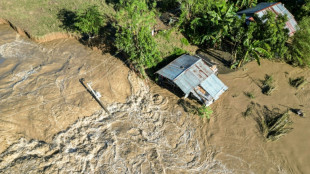
-
 'Minecraft' to come to life in UK and US under theme park deal
'Minecraft' to come to life in UK and US under theme park deal
-
IMF, Ukraine, reach agreement on $1.1 bn loan disbursement

-
 Japan on cusp of World Cup as Son scores in Palestine draw
Japan on cusp of World Cup as Son scores in Palestine draw
-
Chelsea condemn 'hateful' homophobic abuse towards Kerr, Mewis

-
 Hamilton to race final three grands prix of Mercedes career
Hamilton to race final three grands prix of Mercedes career
-
Gatland has not become a 'bad coach' says Springboks' Erasmus

-
 Slovakia take Britain to doubles decider in BJK Cup semis
Slovakia take Britain to doubles decider in BJK Cup semis
-
Brazil arrests soldiers over alleged 2022 Lula assassination plot

-
 Ukraine war and climate stalemate loom over G20 summit
Ukraine war and climate stalemate loom over G20 summit
-
Ukraine fires first US long-range missiles into Russia

-
 Retiring Nadal to play singles for Spain against Netherlands in Davis Cup
Retiring Nadal to play singles for Spain against Netherlands in Davis Cup
-
Rain ruins Sri Lanka's final ODI against New Zealand

-
 Stocks sink on fears of Ukraine-Russia escalation
Stocks sink on fears of Ukraine-Russia escalation
-
Hendrikse brothers start for South Africa against Wales

-
 Macron tells Xi he shares desire for 'durable peace' in Ukraine
Macron tells Xi he shares desire for 'durable peace' in Ukraine
-
Ruthless Japan beat China to move to brink of World Cup qualification

-
 French farmers threaten 'chaos' over proposed EU-Mercosur deal
French farmers threaten 'chaos' over proposed EU-Mercosur deal
-
Brazil arrests G20 guards over alleged 2022 Lula assassination plot

-
 China's Xi urges 'strategic' ties in talks with Germany's Scholz
China's Xi urges 'strategic' ties in talks with Germany's Scholz
-
Raducanu gives Britain lead on Slovakia in BJK Cup semis

-
 Russia says Ukraine fired first US-long range missiles
Russia says Ukraine fired first US-long range missiles
-
COP29 negotiators strive for deal after G20 'marching orders'

-
 Walmart lifts full-year forecast after strong Q3
Walmart lifts full-year forecast after strong Q3
-
British farmers protest in London over inheritance tax change

-
 NATO holds large Arctic exercises in Russia's backyard
NATO holds large Arctic exercises in Russia's backyard
-
Trouble brews in India's Manipur state

-
 Son of Norwegian princess arrested on suspicion of rape
Son of Norwegian princess arrested on suspicion of rape
-
Romanian court says 'irregularities' in influencer Andrew Tate's indictment

-
 Iran faces fresh censure over lack of cooperation at UN nuclear meeting
Iran faces fresh censure over lack of cooperation at UN nuclear meeting
-
Despondency and defiance as 45 Hong Kong campaigners jailed

-
 Scholar, lawmakers and journalist among Hong Kongers jailed
Scholar, lawmakers and journalist among Hong Kongers jailed
-
European stocks slide on fears of Russia-Ukraine escalation

-
 Police break up Georgia vote protest as president mounts court challenge
Police break up Georgia vote protest as president mounts court challenge
-
Spain royals visit flood epicentre after chaotic trip

-
 France's Gisele Pelicot says 'macho' society must change attitude on rape
France's Gisele Pelicot says 'macho' society must change attitude on rape
-
G20 leaders talk climate, wars -- and brace for Trump's return

-
 US lawmaker accuses Azerbaijan in near 'assault' at COP29
US lawmaker accuses Azerbaijan in near 'assault' at COP29
-
Tuchel's England have 'tools' to win World Cup, says Carsley

-
 Federer hails 'historic' Nadal ahead of imminent retirement
Federer hails 'historic' Nadal ahead of imminent retirement
-
Ukraine vows no surrender, Kremlin issues nuke threat on 1,000th day of war

-
 Novo Nordisk's obesity drug Wegovy goes on sale in China
Novo Nordisk's obesity drug Wegovy goes on sale in China
-
Spain royals to visit flood epicentre after chaotic trip: media

-
 French farmers step up protests against EU-Mercosur deal
French farmers step up protests against EU-Mercosur deal
-
Rose says Europe Ryder Cup stars play 'for the badge' not money

-
 Negotiators seek to break COP29 impasse after G20 'marching orders'
Negotiators seek to break COP29 impasse after G20 'marching orders'
-
Burst dike leaves Filipino farmers under water

-
 Markets rally after US bounce as Nvidia comes into focus
Markets rally after US bounce as Nvidia comes into focus
-
Crisis-hit Thyssenkrupp books another hefty annual loss

-
 US envoy in Lebanon for talks on halting Israel-Hezbollah war
US envoy in Lebanon for talks on halting Israel-Hezbollah war
-
India to send 5,000 extra troops to quell Manipur unrest

| RBGPF | -0.74% | 59.75 | $ | |
| RYCEF | -2.54% | 6.68 | $ | |
| RIO | 0.23% | 62.266 | $ | |
| BCC | -1.85% | 138.965 | $ | |
| RELX | 0.46% | 45.25 | $ | |
| SCS | -1.13% | 13.052 | $ | |
| VOD | -0.06% | 8.915 | $ | |
| CMSC | -0.02% | 24.62 | $ | |
| CMSD | -0.08% | 24.371 | $ | |
| BCE | 0.65% | 27.408 | $ | |
| BTI | 0.42% | 36.835 | $ | |
| AZN | 0.92% | 63.98 | $ | |
| BP | -1.4% | 29.015 | $ | |
| NGG | 0.91% | 63.48 | $ | |
| GSK | -0.78% | 33.43 | $ | |
| JRI | -0.23% | 13.2 | $ |

War disfigures the cities of southern Ukraine
It is here on the charming Deribasovska pedestrian street that Viktor Oliynik has planted his easel to capture in pastel colours the wartime transformation of Odessa, whose architectural gems are now partially hidden behind sandbags.
Meanwhile, the city of Mykolaiv 130 kilometres (80 miles) to the northeast bears some scars from holding back the advance of Russian forces from occupied Crimea to the port city of Odessa.
After five weeks of war, the cities are barely recognisable even to their residents.
Turning his back to some of the Odessa street's emblematic sites, such as the former Bolshaya Moskovskaya hotel, an Art Nouveau jewel also known as the House of Faces for the decorations that adorn its facade, Oliynik attacked his canvas in the soft light of the late afternoon.
"I'm used to painting Odessa," said the artist sporting a three-day stubble and black beret perched on his head.
"But today I'm taking advantage of this situation, I never would have imagined such a scene," taking a second to point with his brush to the obstacles and fortifications along the street bordered by an elegant garden.
"This is how an epoch of chaos gives way to an epoch of equilibrium," he prophesied in a dramatic voice.
- 'Hurtful' transformation -
Further up the street, on the square outside the Transfiguration church, men are engrossed in games of dominos, chess and backgammon, oblivious to the sporadic wails of air raid sirens.
"It's really hurtful" to see the extent of the transformation of one's hometown, said Vladyslav Haidarzhi, 25, who has been volunteering to deliver aid to troops and hospitals in Mykolaiv.
"For example some of my friends who left Odessa on the first day of war and came back after one month were shocked," he told AFP.
"They were shocked to see that many roads are closed with different steel objects in order to make traffic of cars slower," he said.
"They could not believe their eyes."
- Urban deforestation -
Meanwhile, the centre of Mykolaiv is relatively unscathed despite the city being close to the frontlines, with one big exception: a missile strike on Tuesday punched a massive hole in the regional administrative building. It killed 28 people according to the latest count.
Nevertheless the city has been transformed.
For the past several weeks the sound of chainsaws has been heard along the main streets.
Hundreds of trees have been felled and left on the roadside.
With no official explanation forthcoming from the city authorities, speculation swirled as to why the trees were chopped down.
A local florist shared the most popular theories: to reduce pollen, widen the streets for military traffic, or to ensure fallen branches don't knock out electricity lines.
But one of the emergency services workers, Pavel Katsan, who was part of a clearcutting team, said he knew the real reason.
"We're cutting the trees to provide firewood for the Territorial Defence" units which have seen their ranks swell with civilian volunteers since the Russian invasion began on February 24.
"We cut down some in spring to reduce allergies," he confirmed. "But this year is different."
Residents remain stoic and defiant.
For the moment, the sandbag-filling operation on Odessa's beach for use in the city centre has been halted, said one of the volunteers.
"First we win, then we clean our city," Dmytro Kyryk AFP.
"And it will be better than before."
D.Johnson--AT
